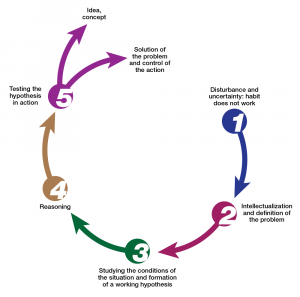Reflective Practice
Learning Objectives
After reading this chapter, you will be able to:
- To interpret and examine the role of reflective practice in early years education.
- Define reflective practice and how it relates to your role as an early years professional.
- To review the study of reflective practice by examining theories and reflective models.
Reflective Practice
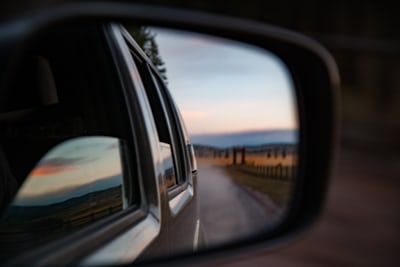
Reflective practice is “a dialogue of thinking and doing through which I become more skillful” – Donald Schon (1983)
How often do you find yourself replaying the events of the day? Whether it is going through a conversation that happened with a colleague or thinking about how certain events led you to make a decision (Third, 2015). How are you feeling about your decisions? Often this process of reflection happens without us even knowing.
Reflection can be described as a learning tool, something that is going to help you to synthesize, explain, and make sense of something, while developing meaning from your experiences. It can be considered to be a professional competence, a skill but more likely a disposition. It is through examining our heart, our values and our thinking we can examine and rethink our pedagogical practice.
Reflective practice is not something that comes to us as a natural skill, and is not inherently comfortable for most of us. This resource is meant for the reader to uncover their own perspective on reflective practice to determine their own level of skill or disposition and to try out activities that will support an intentional way of being. The reader will be encouraged to question, to act on one’s curiosity, to be a researcher and to ask the questions like, “why am I doing what I am doing?”
Reflective practice focuses on one’s thoughts about their experiences, why things happened the way they did and how we can improve on these experiences. This resource will guide you through the basics of what reflective practice is, its benefits, how to integrate it into your everyday life and explore reflective tools such as writing, blogging, and creating a circle of professional support .
As the profession of early years education itself is experiencing transformation, educators too are looking to redefine and transform their practice. This resource will examine reflective practice through the lens of educators while investigating the theory of reflection and how reflective tools can support a practice from a psychological, social, spiritual and educational context.
Finally, the research suggests there is evidence that writing can influence the ability of educators to elevate their reflective practice skills in their daily work with children, families and colleagues. Reflective writing prompts throughout this resource will allow the reader to examine and hold their thinking in place in order to have dialogue and reflect on their practice. As educators begin their journey through the reflective process, writing can act as a catalyst to embrace new skills and pedagogical practices (Third, 2015).
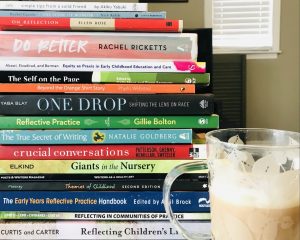
“Reflective practice is the ability to reflect on one’s actions so as to engage in a process of continuous learning” – Donald Schon
Why Reflective Practice?
We all undertake activities to think about our experiences, learn from them and develop a plan for what we will do or continue to do. Can you think of a time when you came home at the end of a week where everything had gone wrong? Or maybe when everything had gone well? What are your next steps?. Are you able to answer the question “why am I doing what I am doing?” In order to continue to develop a reflective practice within our workplace with colleagues, children and families we need to examine and understand the reasons for our reactions, our feelings and our interactions with others, which in turn leads us to becoming a reflective practitioner.
Reflective practice is something which has developed across many disciplines such as teaching, to learn from our experiences. There was a time when reflective practice would have been considered an optional skill or a desired disposition but over the past few years, reflective practice is no longer considered an optional skill but a required disposition.
Reflective Practice has been defined by many including Bolton (2014), Moon (2001), Rogers (2002) and Schön (1983). Reflective Practice is a systematic rigorous self-directed meaning-making process where a person moves from one experience to another through the development of insights and practice with the intention of coming to a deeper understanding of one‘s personal values and intellectual growth. Schön (1983) suggests that, in practice, reflection often begins when a routine response produces a surprise or an unexpected outcome. The surprise gets our attention, which may begin a process of reflection. Reflective practice is “a dialogue of thinking and doing through which one becomes more skillful” (Schön, 1983, p. 56).
Reflective Practice according to the College of Early Childhood Educators of Ontario
An approach used by educators to analyze and think critically about their professional practice with the intention to better understand and improve their practice. Reflective practice is thoughtful, action-oriented and often, a collaborative effort. Educators use reflective practice to plan, evaluate their strengths and challenges, make decisions and create change, if necessary. Self-reflection, critical reflection and collaborative inquiry are all important elements of reflective practice (College of ECE, 2017).
Although a definition of reflective practice has been included this is only one part of the reflective process. Reflection is a very personal skill or disposition and different people will define it in different ways. It is important to remember that there is no one ‘correct’ way of defining what reflection is or how it should be done as a lot of this will depend on your own personal circumstances and work environment. For this reason this resource will explore elements of reflective practice that will help the practitioner develop their own practice. In describing reflective practice, I have interchangeably referred to it as a skill and / or a disposition . This is related to the current literature and discourse that suggests reflection is not a natural skill but rather a way of being or disposition . It involves an evaluation of our ethics, values and feelings around experiences. We will explore this idea later in Chapter 6.
Dig Deeper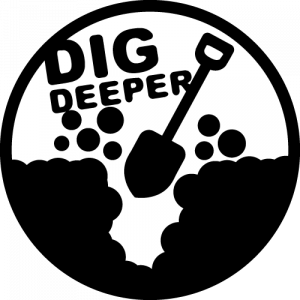
For more information on this topic check out the resource links below.
- Reflective Practice and Self-Directed Learning by the College of Early Childhood Educators
- Getting started with Reflective Practice by Cambridge International Education
Teaching and Learning Team - Research Article Revisiting reflective practice in an era of teacher education reform: A self-study of an early childhood teacher education program by Sophia Han, Jolyn Blank and Ilene R. Berson.
- The Ontario Ministry of Education. (2013). Capacity Building Series: Culturally Responsive Pedagogy
Beginning Theories of Reflective Practice

“We do not learn from experience. We learn from reflecting on experience.” – John Dewey (1933)
John Dewey
The fundamental theories and models of reflection and reflective practice were born initially from the work of Dewey and Schön. A century ago, John Dewey emphasized the importance of involving the learner in reflection. He believed that our experiences shape us, and when reflective practice is part of learning, meaning and relevancy is created, which initiates growth and change (Dewey, 1933).
Video: John Dewey
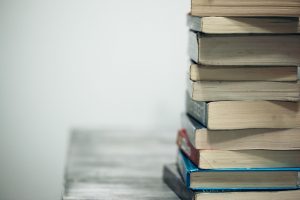
Donald Schön
Schön (1983) based his work on that of Dewey and is most widely known for his theory of reflecting in and reflecting on one’s practice. His theory was grounded in reflection from a professional knowledge and learning perspective (Bolton, 2014.p.6). In simple terms this is described as reflecting as the experience is occurring or reflecting on the experience after it has occurred. Reflecting in action refers to situations such as: thinking on your feet, acting straight away, and thinking about what to do next. Reflecting on action means you are thinking about what you would do differently next time, taking time to process (Bolton, 2014.p.6).
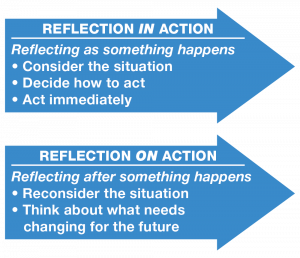
Video: Reflective Practice
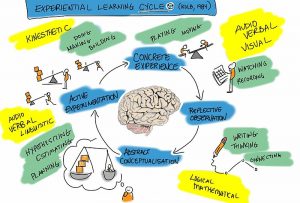
David Kolb
Kolb’s model (1984) is based on theories about how people learn, this model centers on the concept of developing understanding through actual experiences and contains four key stages:
- Concrete experience
- Reflective observation
- Abstract conceptualization
- Active experimentation
The model argues that we start with an experience – either a repeat of something that has happened before or something completely new to us. The next stage involves us reflecting on the experience and noting anything about it which we haven’t come across before. We then start to develop new ideas as a result, for example when something unexpected has happened we try to work out why this might be. The final stage involves us applying our new ideas to different situations. This demonstrates learning as a direct result of our experiences and reflections. This model is similar to one used by small children when learning basic concepts such as hot and cold. They may touch something hot, be burned and be more cautious about touching something which could potentially hurt them in the future.
Video: Kolb’s Reflective Cycle
Learn more about Kolb’s Reflective Cycle by watching the video by Cheryl Reynolds [2:47] below.

Graham Gibbs
This model builds on the others and adds more stages. It is one of the more complex models of reflection but it may be that you find having multiple stages of the process to guide you reassuring. Gibb’s cycle (1998) contains six stages:
- Experience
- Feelings
- Evaluation
- Analysis
- Conclusion
- Action plan
As with other models, Gibb’s begins with an outline of the experience being reflected on. It then encourages us to focus on our feelings about the experience, both during it and after. The next step involves evaluating the experience – what was good or bad about it from our point of view? We can then use this evaluation to analyze the situation and try to make sense of it. This analysis will result in a conclusion about what other actions (if any) we could have taken to reach a different outcome. The final stage involves building an action plan of steps which we can take the next time we find ourselves in a similar situation.
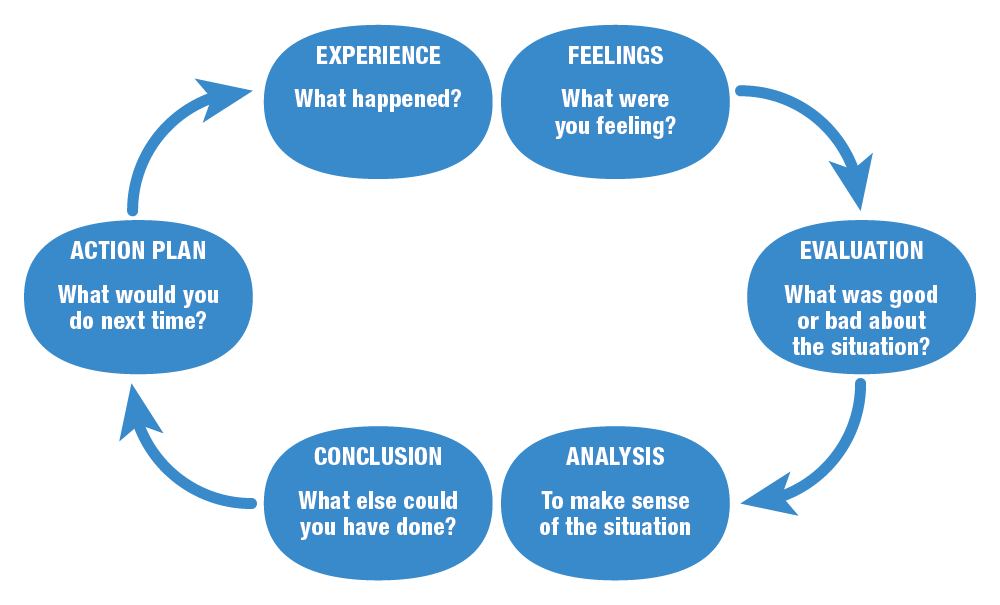
Video: Gibb’s Reflective Cycle for Self Development
Learn more about Gibb’s Reflective Cycle for Self Development by watching the video by Alan Jones [4:42] below.
Dig Deeper
- Learning as Reflective” through First Peoples Principles of Learning
- Reflective Practice Toolkit – LibGuides at University of Cambridge Subject Libraries
- Reflective Practice – LibGuides at Dundalk Institute of Technology
- The effects of regular reflective writing on early childhood educators effectiveness in the workplace by Sheryl Third
Sources
College of Early Childhood Educators (2017). Code of ethics and standards of practice: For registered early childhood educators in Ontario. https://www.college-ece.ca/en/Documents/Code_and_Standards_2017.pdf
Learning to teach: becoming a reflective practitioner by The Open University is licensed under the Creative Commons Attribution-NonCommercial-ShareAlike 4.0 International Licence.
Schön, D. A. (1983). The Reflective Practitioner: How Professionals Think in Action. New York: Basic Books.
Learning to teach: becoming a reflective practitioner by The Open University is licensed under the Creative Commons Attribution-NonCommercial-ShareAlike 4.0 International Licence.
Reflective Practice Toolkit by Cambridge University Libraries is licensed under the Creative Commons Attribution-NonCommercial-ShareAlike 4.0 International Licence.
Schön, D. A. (1983). The Reflective Practitioner: How Professionals Think in Action. New York: Basic Books, 31.
Third, S. (2015). “The effects of regular reflective writing on early childhood educators effectiveness in the workplace” [Unpublished paper] Masters of Arts – Integrated Studies, Athabasca University.
Dewey, J. (1933). How We Think: A Restatement of the Relation of Reflective Thinking to the Educative Process. Boston: D. C. Health
Al-Amrani, S. N. (2021). Developing a framework for reviewing and designing courses in higher education: A case study of a post-graduate course at Sohar University. SSRN Electronic Journal. https://papers.ssrn.com/sol3/papers.cfm?abstract_id=3811202
Bolton, G. (2014). Reflective Practice: Writing and Professional Development (4th ed.). Los Angeles: SAGE.
Schön, D. A. (1983). The Reflective Practitioner: How Professionals Think in Action. New York: Basic Books.
Kolb, D. A. (1984). Experiential learning: Experience as the Source of Learning and Development. Englewood Cliffs, NJ: Prentice-Hall.
Gibbs, G. (1988). Learning by Doing: A Guide to Teaching and Learning Methods. London: Further Education Unit.

